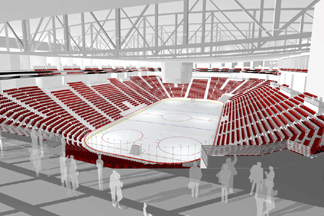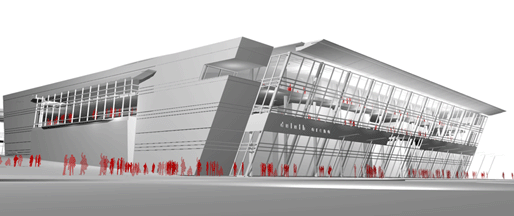October
19, 2005
Postcard:
DECC-adence? Hardly
By
Jess Myers
Picture
this scenario: You’re a father of two sons, one of
them 16 and the other 14. They’re both good bicyclists
and they race competitively, often against one another.
For the older one, you purchase a top-of-the-line 15-speed
racing bike. For the younger one, you provide an antique
three-speed Schwinn with a basket on the front. Then you
wish them both good luck, and the race begins.
For
many fans, city officials and athletic department higher-ups
at Minnesota Duluth, this is akin to how they feel they’re
being treated by the University of Minnesota system –
the folks who ultimately control the athletic purse strings
for the U of M’s four campuses.
Two
of those campuses are in Minneapolis and Duluth, and both
have D-I hockey programs for men and women. But whereas
the Minneapolis-based Golden Gophers play in relatively
new (Mariucci arena opened in 1993) state-of-the-art, on-campus
facilities, their Duluthian counterparts, the Bulldogs,
play five miles from campus in a city-owned convention facility
that’s nearly 40 years old.
In hopes
of keeping the current Bulldog freshmen from having to play
in a 43-year-old, off-campus convention facility when they’re
seniors, a full-blown effort to build a new facility in
the shadow of the city’s famed Aerial Lift Bridge
is underway. Recently, school and city officials met with
several members of the Minnesota Senate’s Capital
Investment Committee, showing them detailed plans for a
new 6,630-seat rink they want built in the parking lot of
the current arena.
Duluth
mayor Herb Bergson got right to the root of the issue, saying
that it’s becoming harder and harder for UMD to compete
for top hockey recruits when the school is offering them
a home rink that’s the oldest (and third-smallest)
in the WCHA.
 |
| The
new arena Duluth and UMD officials covet would accommodate
more than 6,600 hockey fans. |
The
new building is projected to cost $67 million. While asking
the state to pay for half of that (the rest would be financed
through a city-wide sales tax increase on food and drink),
project backers point out that the price tag is modest in
comparison to the estimated $478 million for a new Minnesota
Twins ballpark, the $675 million stadium the Minnesota Vikings
want or even the proposed new $235 million home of Golden
Gopher football.
While
acknowledging that his team’s current home has atmosphere
and character that can’t be matched in the league’s
newer facilities, Bulldog coach Scott Sandelin is squarely
behind the new project.
“It’s
time that we get a new rink,” says Sandelin. “I
love the rink that we play in, but you’ve gotta keep
up with the Joneses.”
The
facility issue is far from a new one at UMD. The Bulldogs
christened the DECC (then called the Duluth Arena) on Nov.
19, 1966, pasting the Gophers 8-1 behind a school-record
six assists from Keith “Huffer” Christiansen,
the school’s first hockey All- American. But even
then there was howling that the team belonged on campus,
not downtown. Nearly four decades later, the debate still
rages with residents living near the UMD campus and downtown
hotel and restaurant managers steadfastly opposed to having
the region’s top sports draw play anywhere other than
the downtown waterfront.
 |
| An
artist's rendering of the exterior of the proposed Duluth
arena. |
UMD
vice chancellor Greg Fox describes the new DECC project
as “far more beautiful and more multi-purpose than
what we’d be able to build on campus,” and notes
that the school has committed to paying upwards of $16 million
in rent over the new building’s first 25 years.
Of course,
myriad questions remain unanswered and there are dozens
of hurdles to clear before backers can meet their goal of
breaking ground in early 2007 and a first face-off in October
2008. Step one toward meeting those deadlines will be convincing
the state legislature and Minnesota Gov. Tim Pawlenty (a
big Gopher hockey fan) to approve the necessary state funding.
The
2006 Minnesota legislative session starts in March and with
elections looming roughly a year from now, sports facility
issues are predicted to be tough votes. Supporters note
that a delay could be spendy not only in missed recruits,
but also in the potential for skyrocketing construction
costs in the wake of the Gulf Coast hurricanes.
“If
it doesn’t happen, we’ll fix up what we have
and do what we can,” says Sandelin. He doesn’t
bother to note that his team, three-speed Schwinn and all,
is 6-2 in its last eight races versus that older brother
with the 15-speed racing bike.